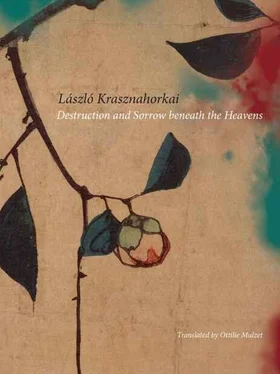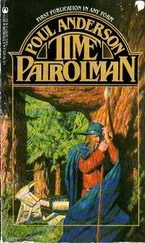So that, well, now I would simply finish what I have to say by repeating, and emphasizing, that the work of the artist is to find his own relation to his own culture. The artists of today should be the same as they were in the days of old: in order to bring forth their works, they must withdraw from the world, they must keep a great distance from it and they must create a completely individual way of life. An artist cannot be identical with a member of society. His role, his significance is extraordinary — if he loses it, nothing will come in its place.
Altogether that is what he says, he remains for a moment on the bed, leaning back on his hands, as if he were thinking over his words and if they corresponded to what he unconditionally wanted to say; then suddenly he excuses himself, he has no more time, he nervously says goodbye in the doorway and already he has disappeared into the colossal building.
They never see him again, and later on when Stein makes some attempts to find him — in vain — he cannot explain the event in any way other than to think that Xiao Hai is an envoy, an emissary, a messenger of what is to come; and yet the envoy, the emissary, the messenger is quick, he gets to the point, transmitting what has been entrusted to him, and already he is gone, he runs on further.
The Road That Leads There, 2
They lose all trace of Xiao Hai, but his being is still there somewhere in the background because, thanks to his hidden manoeuvres, they end up the next day back in the Zhuozheng Yuan which, in terms of its meaning, can only be translated stupidly, and they do translate it stupidly, because it sounds something like ‘The Garden of the Politics of the Common Man’—obviously a quotation, namely, from Pan Yue,[186] as well as the fact that this brilliant designation of this artful garden, existing as it does amid the rules of the Chinese language and spirit, is, however, completely untranslatable, or only in this clumsy and misleading form, so that Stein does not even try to interrogate the garden’s dignified director as to its name when, at exactly eleven o’clock in the morning, he appears at the crowded entrance to the garden to receive him, and leads Stein across a tangled confusion of passageways and side gardens, through an area closed to the public, into a large, magnificent pavilion, the receiving hall of the Zhuozheng Yuan, offering Stein a seat in one of two wondrous Ming-era armchairs placed in the middle of the hall.
After the formulaic introductory courtesies, Stein requests the director’s forbearance, as he, in a manner uncommon here in China, tends to get straight to the point of the questions that concern him, so if the director will excuse him — he nods towards him once again, asking for his leniency — he, Stein will once again proceed in this manner. He will burden the director with such questions that he has certainly heard and answered thousands and thousands of times: Would he be so kind, Stein smiles at him, to answer these questions this time as well? First and foremost, he is curious as to the origins, in other words, what led to the creation of the Chinese garden? How did it happen that the garden — came to be?
fang piehe. The oldest foundations are represented by the culture of the Wu State.[187] The Wu State designates the region to the south of the Yangtze. The intellectuals and literati of the Wu discovered that, in expressing their feelings through man-made lakes, mountains, plants, pavilions and furnishings, they could create a kind of reality in which their emotions would be manifested. The gardens of Suzhou, however, originate directly from Chinese landscape painting. For example, the garden connected to the receiving room in which we now sit was planned 500 years ago by the owner of the garden, a reclusive censor by the name of Wang Xianchen,[188] on the basis of his own conceptions as well as those of traditional landscape painting. In his garden, it is not nature as such that is depicted but, rather, nature as it appears in Chinese landscape painting.
So then, as a matter of fact, the Chinese garden should be viewed as fine art, to be completely precise, as an artistic creation? One that would have nothing to do with the reality of nature?
fang. Everything that you see in this or any other garden in Suzhou is, down to the last detail, man-made. Every tree and every plant has been placed there by a person, every strip of vegetation running along a wall has been planned by a human being. Even how it should run along that wall has been planned. At the same time, the Chinese gardens in Zhuozheng — and this applies to ours here as well — gather together differing spiritual strands: the original Taoist conception of immortality, the eternal desire of a Chinese person to be free of the burdens of life, to immerse himself in nature, in the solitary worlds of the mountain and the waters,[189] just as there is present the desire of the old Chinese world to express what it knows of the universe, and to wonder at this, and there is joy as well, joy which can be savoured in a garden planned for tranquillity, peace and unclouded freedom. The garden was always a source of joy, and it has remained so.
It is clear that it is not an official sitting across from Stein but a scholar. Stein asks: What, more specifically, was the goal of the original owner of the gardens? What kind of person was he? What kind of feelings was he trying to express here?
fang. The most important thing is that the garden of Suzhou was always a garden of joy, namely, of the enjoyment of the natural world. That is — and this is important — these gardens were built for reasons of delight. And the attainment of that delight, that joy, that happiness was the real goal of the owner as well as the builder of any other garden. Regarding the philosophical content of this garden, that would be difficult to determine. He did not build it — and this is the important thing — as a direct statement of a philosophical thought or picture. It would be a mistake to think that. It was because of joy. Because of delight. It is altogether another question of how this intention — this intention of delight — immanently contained a philosophical thought in every instance.
Did the owners live in these gardens? Was this also their residence? Or did they come here from where they lived to delight in the densely manmade reality of the life of nature?
fang. In Suzhou, the owners lived in the gardens as well. I think this was the norm. In every case, these structures are comprised of two large parts: in the front are the living quarters, in Chinese, zhaiyuan; and in the back is the garden: houyuan, both of which build upon the principle of feng shui:[190] ‘The house must be in front, the garden must be at the back.’ Feng shui determined every essential matter in terms of the construction.
The conversation then continues, with the guest attempting to explain why the Chinese garden fascinates him so much. He could say — he leans in closer to the director — that in addition to its elegant design, it is possible that it is because he merely finds the origin of the garden — whatever it may be — to be simply captivating. He is certain that the director has heard such words from his guests while sitting in these beautiful chairs. He, however — Stein motions towards him somewhat confidentially — is fascinated by all this due to something else, the knowledge of which the director himself will possess. And Stein relates that he is fundamentally concerned with the essence of classical culture — and given that this traditional culture, for the most part, has over the past hundred years been destroyed — he wonders if there might be a genre of this traditional culture which, due to some practical, some kind of simple, some kind of palpable reason, might not have disappeared. Which can in a material sense be annihilated but in its essence never, and because of that may be brought back to life again and again. And he thinks that one of these indestructible forms could be the Chinese garden. Because here, the Chinese garden, as an articulation of the classical spirit in an exquisite form, in a given garden, or a neighbouring garden, can nonetheless be destroyed, but the Garden in its own spirit remains — since neither can all the plants be expunged from the earth, nor the stones be made to vanish for all time, nor the plans of the pavilions and their depictions, nor all the books that describe the rules of their construction, those can’t be burnt or pulped or otherwise made unreadable — so that, if today, someone faithfully follows the prescriptions of tradition, then in every case the original may be rebuilt, namely — Stein continues his train of thought — there still remains something, the Chinese garden: itself destroyed, and what was in it destroyed, and yet it can be resurrected! He has visited many gardens, Stein says, now adapting the most intimate of tones, but, to put it briefly, he did not come across many validations of his original theory. And yet now, on his current trip, thanks to happenstance, happenstance which led him to the gardens of Suzhou. .
Читать дальше












